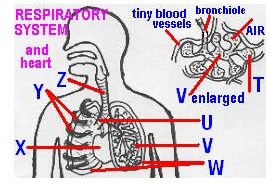Respiration quiz
15 QuestionsQuiz Description
Our main focus in this quiz will be on breathing which is a biological process that all humans alive, animals and plants portray. We take in air all the time and release air all the time. Energy gotten through respiration is used for Growth, metabolism, development as well as maintenance. Here you will find a lot of fascinating topics on Biology such as this. And After you take this quiz, you will learn some new terms, like inspiration, expiration, inhalation, exhalation, bronchi, bronchus and so many other interesting words.
Respiration in its simplest term is the taking in of Oxygen and sending out of Carbon Dioxide. Or It can simply be defined as breathing. Respiration in man occurs when a man takes in air(inhales), and sends out air(exhales). When this happens, a series of metabolic activities occur in our body system from our mouth to the lungs which is the main organ of respiration.
Respiration from plants and animals helps to balance the CO2:O2 concentration in the atmosphere, and also helps us to keep living as these metabolic activities are needed for one to be alive.
Do you want to know how good you are in Biology, respiration in particular? There are hundreds of quizzes on our website, do well to check them out after this. Take the quiz and find out.
Please Enjoy!!!
The gases from (i) air breathed in, (ii) air breathed out, (iii) just above a lit bunsen burner flame and (iv) the gases left over after burning a candle inside an up-turned beaker where analysed. From the results quoted below, which analysis is most likely to be from the bunsen flame?
A manual roadworker, an office worker, a marathon runner in training and an injured person all have different daily energy requirements in kJ/day. Respiration supplies the energy needs of them. Which of the following is the most likely energy requirement of the marathon runner?
A manual roadworker, an office worker, a marathon runner in training and an injured person all have different daily energy requirements in kJ/day. Respiration supplies the energy needs of them. Which of the following is the most likely energy requirement of the road gang worker?
Respiration equation: __(1)__ + __(2)__ > __(3)__ + __(4)__ (1) is a soluble solid, when heated with Benedicts solution a red-brown colour is formed. (2) is a gas, when pure, relights a glowing splint. (3) is a gas that bubbled into limewater turns it cloudy. (4) is a colourless liquid boiling at 100 oC. What is the chemical identity of (2)?
Below is a list of molecules involved in energy production from digestion and respiration. Which is the formula for glucose?
Respiration equation: __(1)__ + __(2)__ > __(3)__ + __(4)__ (1) is a soluble solid that might be described as the 'fuel'. (2) is a gas breathed in from air. (3) is a gas breathed out from the lungs. (4) is a colourless liquid. What is the chemical identity of (3)?



